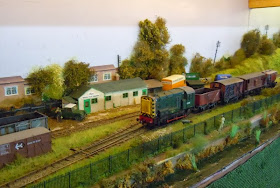At the Arundel show I was chatting to Chris Ford about his recent posts on a
"one-lift" layout, that is a single-board layout that is quick to erect at exhibitions, yet easy to transport. In particular he was asking for ideas for fiddle-yards that fold out, though as an alternative thought, I've built some fiddle yards that are separate but designed to be quick and easy to fit.
Awngate's fiddle yard does not fold out but is quickly fitted without bolts, catches, connectors, or additional support. In it's original location the fiddle yard could be connected overhanging the mantelpiece and there was no space or access for bolts or the like.
The side timbers of the fiddle yard board are extended beyond the end - the timber is about 12mm x 20mm I think. You can see the lead-track (for the cassettes) is soldered to PCB sleepers, and there are brass wire contacts protruding.
The fiddle yard board is simply slid into holes left in the end of the main board which are a tight fit (by being formed of the same timber). A firm press slides them in, and friction is enough to hold the board in place. Here you can see the drawer runners that the layout rested on, allowing it to be pulled clear of it's alcove.
Once pushed home the wire contacts have engaged with brass pads on the main board, so connecting the fiddle yard with power without the need for any connecting wires.
This shot of the whole layout shows the fiddle yard cantilevered from the main board (the shadow beneath it is the trestle support, but the fiddle yard does not touch it). Of course this fiddle yard is small (about 18" x 5") and not heavily loaded, but I guess Chris is planning for the same sorts of trains as I run, It's worth noting that if the board was hinged down from the end of the main board it would be taller than the main layout, and add weight.
As another idea, it has struck me that a sector-plate type fiddle yard does not really need a baseboard at all, just a pivoted support where it rotates (i.e. a bolt), and a sliding support to keep the tracks in alignment and prevent tilt. The sliding support could be as simple as layers of MDF or plastic, or perhaps something clever with aluminium channel. Here are some sketches (as Chris requested) to give some ideas:

The first scheme shows how the sector plate can be fitted to the corner of a baseboard with half (or more) of the sector plate overhanging the board. This would work where it can be hidden with scenic features, however to save giving any of the main board over to the fiddle yard, why not move the pivot off the board? The second scheme puts the pivot onto a small fold-down extension - although I have sketched this to be the full width of the baseboard it could of course be just a few inches wide. The third scheme has fold out arms to provide the pivot, I've shown two equal arms that link with a split hinge pin to hold them in the open position.
There are other arrangements that could be considered - a single hinge-out arm held in place with a catch, or perhaps a beam that pulls out of the main baseboard like a drawer. The sector plate could of course become a turntable by arranging the pivot in the centre and allowing it to rotate all the way round (but provide end-stops for the tracks!), or if you prefer just provide a fixed deck for simple sidings or cassettes.
My point is though, a fiddle yard does not need to be integrated to be quick to fit and light to transport, and can be added to a "one-lift" layout without taking up valuable scenic space. A secondary point is that fiddle yards need to be fit-for-purpose, but don't have to be over-engineered as many are; for example my cassettes made from plastic trunking work as well as any I've seen and are quicker to make (and lighter to handle) than elegant wood and aluminium designs.










